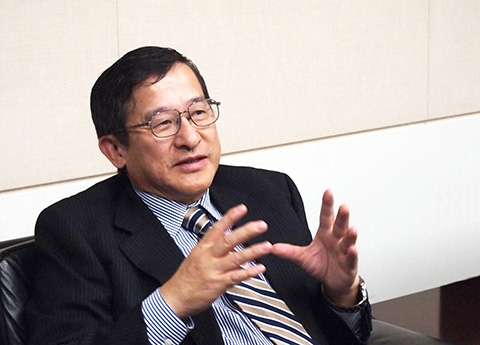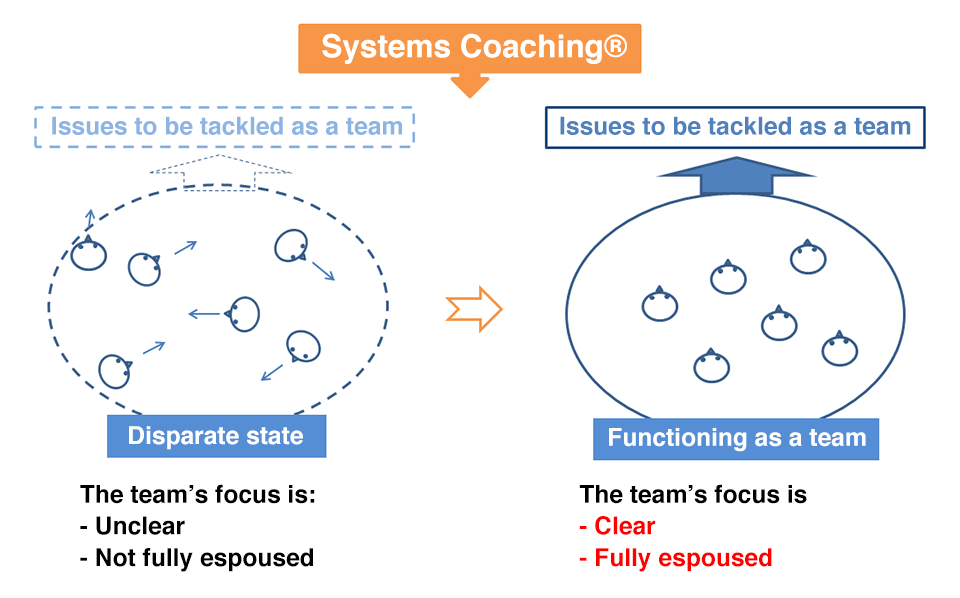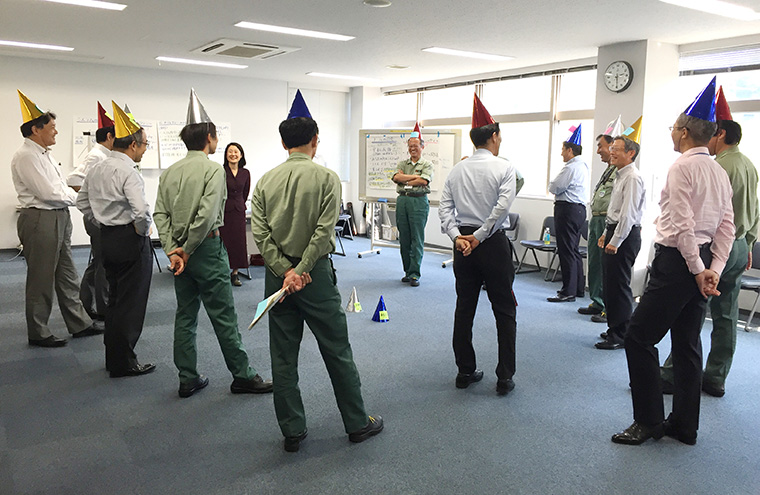01
Open-hearted Dialogues Realize
a Culture of Unity for R&D
that Leads to Business
Mitsui Chemicals, Inc.
We asked Dr. Shigeru Isayama about the process. Dr. Isayama is a Representative Director and Senior Managing Executive Officer who headed the R&D Division when the development program began.
Interviewer: Takeshi Shimamura (Executive Coach/Systems Coach) at WAKE UP, Co., Ltd.
| Industry | Chemicals |
|---|---|
| Sales revenue | JPY 1,550.076 billion (consolidated for the fiscal year ended March 2015) |
| Number of employees | 14,363 (consolidated as of the end of March 2015) |
| Business description | Manufacturing and sales of functional chemicals, functional resins, basic chemicals, and petrochemicals |
Executive Coaching that Brought about Behavioral Changes as a Leader

Shimamura:
We first met during executive coaching, didn’t we?
Isayama:
That was when our company was struggling to stay profitable and I had just become the head of the R&D Center.
Shimamura:
Yes, that’s right.I think your sense of crisis and the intensity of your feelings under those difficult circumstances manifested themselves in the results of the LCP (Leadership Circle Profile: 360-degree assessment based on feedback from all involved).
Isayama:
Although I had anticipated some of the issues identified in the results, frankly speaking I was a bit shocked at how bad I had been (laughs). Therefore, I felt relieved when you said, “Even though you tend to be overbearing toward your subordinates, you will be able to demonstrate great leadership qualities if you learn to creatively use that energy.”
Shimamura:
Once you realized that your sense of crisis about the situation and the intensity of your feelings about your company might be manifesting themselves as overbearing behavior toward your subordinates, you began to change from an attitude of directing your subordinates to one of trying to involve them. I myself was surprised at the speed of this change. I could feel your decisiveness.
Isayama:
I felt that I would be willing to change if it might improve things. As a former researcher, I renewed my desire to revitalize the research at Mitsui Chemicals. It was probably going to be my last job, and the exercise gave me an excellent opportunity to reflect on why I had wanted to become a chemist and what I wanted to accomplish.
Applying the These Changes to the Organization As Well
Shimamura:
Later on, I recall that the topics discussed during coaching sessions began to shift from your own behavioral changes to how your organization should be designed.
Isayama:
Yes, I really wanted to contribute to the company’s profitability by starting up businesses that were initiated by the R&D Center. So, for about a year, I tried various initiatives based on the realizations I gained during coaching sessions. I also developed a budget for the following year, held discussions, and created a structure to carry out activities that cut across all research laboratories. Since what I was advocating was based on the right argument, nobody was against it. However, I did face some obstacles when I tried to implement it in some cases. I felt that what I was advocating wasn’t fully accepted by the laboratory directors.
Shimamura:
That was when the Human Resource Division suggested introduction of Systems Coaching® into the R&D Center, right?
Isayama:
Yes.Because I had already been thinking that I would do everything within my power, I made an instant decision to introduce it. I was hoping that since I was able to change, others would be able to change, too.
From a Culture of Disparity to a Culture of Unity: Dialogue that Transformed the Team
Shimamura:
Systems Coaching® commenced then with 13 members. These members agreed with your strong commitment and conviction that uniting the R&D Center was essential for reforming the company’s business portfolio.
Isayama:
To move the large mountain of the R&ammp;D Center, it was necessary to involve these 13 people, who included research directors of affiliated companies. In the beginning, all members behaved cautiously, and held back from stating their honest opinions, didn’t they? (laughs). Since our company places importance on our ideal form, the members could not help at first playing the roles of managers representing the interests of their respective groups, so they thought they should be cautious about what they said. As a result, the members were disconnected from each other.
Shimamura:
When do you think the turning point was?
Isayama:
I think it was during the first session. We reviewed the historical transitions of the R&D Center over the previous 40 years or so.
Shimamura:
Yes.During a discussion where we reflected on the history of the R&D Center, the members realized that they had not been only the victims of past events, but that they had also been the perpetrators. It was an important moment, wasn’t it?
Isayama:
Yes, it was. I think they pondered on what had been created as a result. They may have felt a sense of futility when they realized that the past bystander attitude hadn’t created anything. I think that was when the members began to tackle the issues with a sense of ownership.
Shimamura:
Afterwards, the team members came to an agreement to create a culture of unity for the R&D Center, didn’t they? Then, to create a culture of unity, the team members developed a slogan to communicate what was important to them.
Isayama:
Repeatedly sending out the same slogan in a united manner is very important for any organization. The fact that the team members learned to do this was significant.


The R&D Center Has Never Been So United
Shimamura:
What was the resulting impact of Systems Coaching® on the R&D Center?
Isayama:
I feel that the members of the R&D Center have never been more united than they are now, in all the time since our company was created through a merger 18 years ago. Faced with the crisis of our company’s worsening business performance, the team members had been feeling they had to do something. Nevertheless, they had been unable to take any steps, bound by a culture of prudent deliberation passed down since the time of the merger. I feel that the recent series of steps have broken the spell and helped all team members to agree on and fully espouse the course of action to be taken.
Shimamura:
Since then, people both inside and outside the company seem to have great expectations about the slogans issued in various fields and the unified development projects.
Isayama:
That’s right. We have been told that we are now conducting research from a customer perspective, and that our sense of purpose for delivering tangible results has become clear and the way we conduct research has definitely changed. Such recognition motivates the R&D Center even more than before. We also received praise for the start of development projects that cut across multiple research laboratories, which is a direct manifestation of the culture of unity.
Shimamura:
There was also a great effect inside the R&D Center, wasn’t there?
Isayama:
It seems that researchers are also feeling motivated because they sense that the research laboratory directors have changed.
Toward Research that Creates New Businesses and New Products
Shimamura:
Are there any future themes you are thinking about?
Isayama:
If we go back to the question of what the R&D Center is for, the answer is to create new business and products for the sake of a sustainable future. The culture of unity and the slogans were created for that purpose. For the next stage, we need to create new customer values through the creation of attractive products that involve the entire company.
Shimamura:
In reviewing Systems Coaching®, one person said that it was the first time they had had an opportunity to voice what they really thought to that extent. Once team members share the experience of talking things through, I think they become able to have frank conversations even in difficult situations.
Isayama:
Yes, the situation can be stressful, but I’m sure they will be able to do that because they are all inherently talented. Research laboratory directors are also traveling to sites inside and outside Japan themselves and taking steps to convey their beliefs using the created slogans. I think they are able to take these actions to demonstrate their commitment as leaders precisely because they fully espoused the role that the entire R&D Center must play. I believe all team members can now view things from a higher viewpoint and that they have matured as leaders.
Shimamura:
That is wonderful. As you had intended, the leaders who gained a sense of ownership of the entire R&D Center have now begun to take action, haven’t they?
Isayama:
Yes. Thanks to you, the organizational reform of the R&D Group has made great strides. From here on, I hope to bring success to new business startups.

